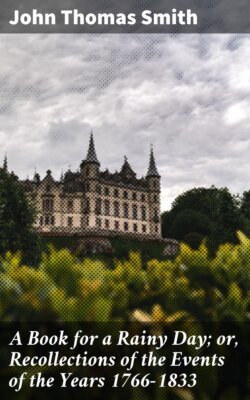Читать книгу A Book for a Rainy Day; or, Recollections of the Events of the Years 1766-1833 - John Thomas Smith - Страница 7
На сайте Литреса книга снята с продажи.
1766.
ОглавлениеTable of Contents
My father informed me, that in the evening of the 23rd of June 1766, which must have been much about the time when Marylebone Gardens echoed the melodious notes of Tommy Lowe,[2] and whilst there was The Devil to Pay at Richmond with Mr. and Mrs. Love,[3] my mother, on returning from a visit to her brother, Mr. Edward Tarr,[4] became so seriously indisposed, that she most strenuously requested him to allow her to return home in a hackney coach, whilst he went to Jermyn Street for Dr. Hunter.[5] Upon that gentleman’s arrival at my father’s door, No. 7, in Great Portland Street,[6] Marylebone, he assisted the nurse in conveying my mother and myself to her chamber. Although I dare not presume to suppose that the vehicle in which I was born had been the equipage of the great John Duke of Marlborough, or Sarah his Duchess, at all events I probably may be correct in the conjecture that the hack was in some degree similar to those introduced by Kip, in his Plates for Strype’s edition of Stowe.[7]
Hackney chairs were then so numerous, that their stands extended round Covent Garden, and often down the adjacent streets;[8] these vehicles frequently enabled physicians to approach their patients in a warm state. The forms of those to which I allude are also given in Kip’s prints above mentioned; and who knows but that they, in their turn, have conveyed Voltaire from the theatre to his lodging in Maiden Lane?[9]
That sedans were of ancient use I make no doubt, as I find one introduced in Sir George Staunton’s Embassy to China.[10] Pliny has stated that his uncle was much accustomed to be carried abroad in a chair.[11] My parents, after a fireside debate, agreed that I should have two Christian names: John, after my grandfather, a Shropshire clothier, whose bust, modelled by my father, was one of the first publicly exhibited by the Associated Artists in 1763, before the establishment of the Royal Academy;[12] and Thomas, to the honour of our family, in remembrance of my great-uncle, Admiral Smith, better known under the appellation of “Tom of Ten Thousand,”[13] of whom I have a spirited half-length portrait, painted by the celebrated Richard Wilson, the landscape painter, previous to his visiting Rome, when he resided in the apartments on the north side of Covent Garden, which had been occupied first by Sir Peter Lely, and afterwards by Sir Godfrey Kneller.[14] From this picture there is an excellent engraving in mezzotinto, by Faber.
I have heard my mother relate, that when at Greenwich this year for the benefit of her health, an aged pie and cheesecake woman lived there, who was accompanied through the town by a goose, who regularly stopped at her customer’s door, and commenced a loud cackling; but that whenever the words “Not to-day” were uttered, off it waddled to the next house, and so on till the business of the day was ended. My mother also remarked, that when ladies walked out, they carried nosegays in their hands, and wore three immense lace ruffle cuffs on each elbow.[15]
In the month of March, this year, died Mary Mogg, at Oakingham, the woman who gave rise to Gay’s celebrated ballad of “Molly Mogg.”[16]
In all ages there has been a fashion in amusements, as well as in dress: grottoes, which were numerous round London, appear by the advertisements to have been places of great resort, but above all Finch’s, in St. George’s Fields, was the favourite. The following is a copy of one of the musical announcements:—
